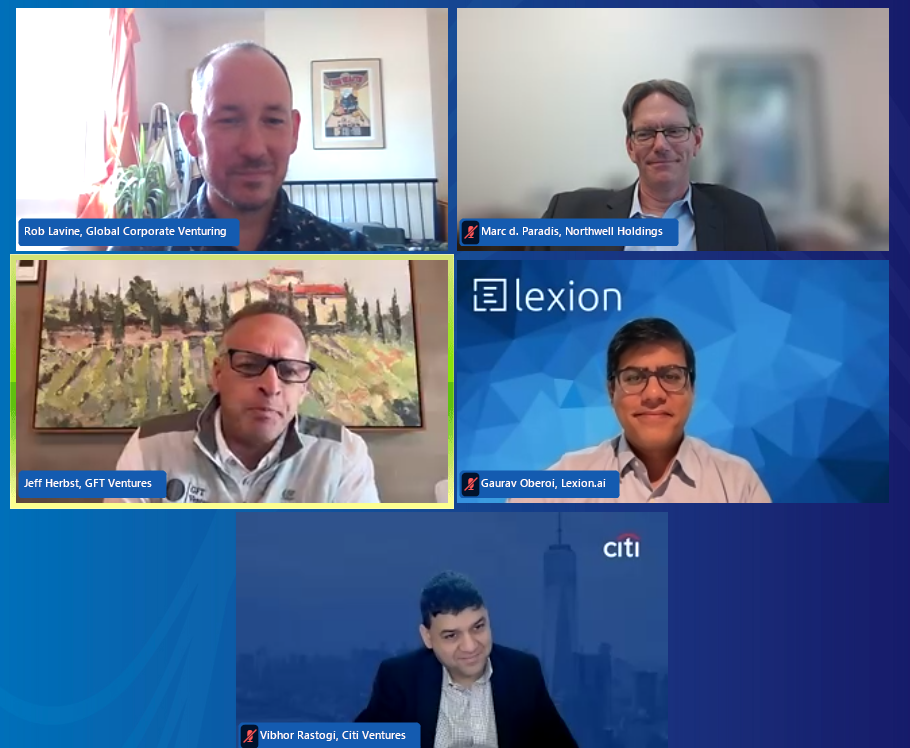The valuations of generative AI startups are high and the tech is still untested, but corporate investors should still take some early bets.

To say that Marc Paradis, vice-president of data strategy at Northwell Holdings, is excited by the potential of generative artificial intelligence, would be an understatement.
“This is the biggest tech transformation that we’ve seen in our lifetimes,” Paradis told our recent webinar How to invest as generative AI startups spread to every industry. “It is bigger than the iPhone, I would argue this is bigger than the internet.”
He’s not alone. Ever since, at the end of last year, when Open AI’s ChatGPT demonstrated a giant leap forward in what the technology could do when harnessed to enough data and compute power, every company has been evaluating just how they can use the technology.
Paradis, who works for the for-profit arm of New York health service provider Northwell Health, for example, believes generative AI could help save the US healthcare system, where there are not enough practitioners and too much paperwork.
“You can’t just simply push a button and have twice as many doctors in a year. You can’t just simply push a button and have twice as many nurses. These are careers that take years decades to train for and so we need to find ways to make individuals more productive and more effective,” he said.
“I think there is really an opportunity for us to take a fundamentally broken system, which is the healthcare delivery system in the in the US, and rework or rethink [it]. We need to leverage these technologies to return to the human aspects of care.”
But investing in generative AI has already become expensive and crowded. Microsoft’s investment in OpenAI has reportedly grown to $13bn, while Google has invested $300m in Anthropic, a rival large language model company. Companies like Salesforce, ServiceNow, Workday and China’s Baidu have all created large investment funds that will focus on AI investments. Sapphire Ventures, the former investment arm of SAP, said last month it plans to put over $1bn into AI startups.
The valuations of AI companies — especially those dealing with the foundation models of generative AI — are what venture capital investors politely call “frothy”.
“You have OpenAI valued at $30bn and Cohere valued at $2bn, Anthropic at $5bn. These are back to 2021 valuations of 100 times revenue,” said Vibhor Rastogi, head of AI Investments at Citi Ventures.
So is there still space for non-tech companies to invest in generative AI? Where are the best places for them to place those bets? Paradis and Rastogi came together with Jeff Herbst, founding managing partner of GFT Ventures and Gaurav Oberoi, chief executive of AI company Lexion.ai to discuss this in our recent webinar: How to invest as generative AI spreads to every industry.
Here are some of the insights they shared:

1. Financial investors should be wary but this is the perfect time for corporates to place bets on generative AI
GFT’s Herbst freely admits that he has sat out this round of investments in generative AI. The valuations are too high and the technology still too untested, he says. “I don’t think it’s ready for primetime yet. I think the next wave is where financial VCs like myself will make our living,” he says.
That said, he thinks there is value in corporate investors with a strategic interest getting involved at this early stage. And that is because investors hold the essential ingredient that these new large language models of AI need: data.
The first wave of AI was around computer vision, says Herbst. This was great for those developing self-driving cars or automating the scanning of X-rays, but use cases were more limited for most businesses. This changes entirely with the new wave of generative AI.
“The new wave is around conversational and data,” says Herbst. And it is the corporates that have the data — businesses like financial services have mountains of unstructured data. “This is the age of corporates and AI because it’s all about data.”
2. Businesses need to step in quickly to steer generative AI companies
Citi Ventures’ Rastogi said early-stage generative AI companies need a steer from corporates to make sure they develop the technology in the right way.
“We can really be a design partner for these generative AI companies as they think about taking a technology developed for the consumer world and look to apply it to enterprise use cases. Corporates can really help them think through the security architecture, legal implications, copyright implications that you need to deploy it at scale,” he said.
Citi Ventures is one of the investors in Lexion.ai, which helps paper-heavy business automate processes like writing and managing contracts and legal documents. Oberoi said the partnership with Citi has been helpful for making sure the company is enterprise ready.
“I’m excited about finding corporate partners that give me access to solving problems for large, regulated industries,” he said.
Paradis said he was hoping to avoid some of the missteps in developing previous waves of AI.
“One of the mistakes made again and again in the history of AI is that people wait too long. These product lines emerge, but they’re developed in a vacuum. There’s a lot that goes into being an enterprise solution and there’s a lot to be said for really deeply understanding the complex set of systems and processes and technologies that live behind something like a financial services institution or healthcare delivery institution,” he said.
3. The real money and opportunity is coming from tailoring generative AI
“I think the underrated business plan is now we have to actually make [generative AI] useful in specific use cases and specific verticals,” said Herbst.
“What we find super exciting is the application category,” agreed Rastogi. The foundational models of generative AI are likely to become commoditised, but there is a lot of scope in building industry specific businesses on top of that base layer, he said.
“Salesforce, famously, is UX built top of Oracle. They should not have become this unusually successful company,” he pointed out. “But if you build the right application and use the infrastructure as a foundation to get to market and build a compelling business, it’s attractive to investors.”
Northwell Holdings is looking to both partner with generative AI companies and create some of its own internal startups in this area. One of the use cases that Paradis mentions is using generative AI to produce personalised summaries of patients’ medical files for doctors.
A long-term patient with complex needs might have 400 or even 4,000 pages of notes in their file — impossible for a clinician to read in a limited time. But generative AI would be able to create summaries of these notes appropriate to a cardiologist or a general practitioner. It can even learn how different cardiologists like to have information presented.
“With generative AI you have this ability for those algorithms to learn how one cardiologist would like to see that information versus another cardiologist. That’s certainly one of the areas we’re looking at very closely,” said Paradis.
4. Companies will need to guard their data
If data is the essential ingredient in generative AI, it is crucial for companies to safeguard.
“Your data is your code. I wouldn’t let anybody steal my code, so ’m not going to let anyone steal my data,” says Herbst.
Already, many companies are pushing back on having their data scraped online — look at the LinkedIn terms of service, for example, and you’ll see they contain a prohibition on extracting large-scale data and using it to build a business. Using someone else’s data to train a generative AI will similarly become a contentious issue.
Worse yet, it is possible to reverse engineer deep learning code to find out what the original inputs were. If the code was trained with a company’s proprietary data, this could be extracted by others through this reverse engineering, said Lexion’s Oberoi.
“With the prior generation of deep learning models it’s very hard to reverse engineer that to spit out the original documents that were fed in. With gen AI, it’s actually very easy to do,” he said.
That is why AI companies must put in place very strong guardrails.
“It is really important that you do not commingle customer data,” said Oberoi. “If we feed [our system] all of our customers contracts together, that would be a major faux pas, because it would be too easy for a customer to accidentally see some portion of text from somebody else.”
Oberoi also believes companies must put in adequate safeguards to check that the answers generative AI tools are coming up with are accurate and appropriate. Generative AI is still prone to “hallucinating” or producing completely off-the-wall answers when it does not have enough information or has been instructed incorrectly. Having mechanisms perform actions such as checking what text the AI is pointing at to generate an answer, or keeping a human in the loop to verify output are some ways companies can avoid expensive and embarrassing mess-ups.
5. Yes, IP rights are going to be a problem
The first lawsuits over intellectual property rights being violated are beginning to trundle through the courts. Art creation systems DeviantArt, Stability AI and Midjourney have been challenged by artists and OpenAI is being sued by two US authors.
“There’s a whole host of issues and the chatter [around IP rights} is starting. I think a year from now, everyone’s going to be talking about this,” said Herbst.
Rastogi said technology companies may increasingly be asked to provide guarantees to users of their technology to make sure they don’t face any intellectual property disputes.
“Increasingly, I can see where some of the gen AI tech companies will be asked by customers to indemnify to make sure that the data that their product is trained on does not violate any copyright,” he said.
The future?
One thing Paradis is looking at is how to bring different types of artificial intelligence together.
“The real transformative aspects are going to come as in the multimodal aspects of this, as we start to bring [together] the vision models and the language models with the spatial orientation and movement models,” he said. It may not be quite the artificial general intelligence that some have feared will take over from humans — but it will enable many more types of tasks to be automated.
And though the market may feel somewhat crowded and expensive now, the panel all agreed there were plenty of opportunities, especially for startups solving some of the current problems around security, transparency and the computing power needs of generative AI.
“The world is going to run on data and pattern recognition on data and AI,” said Herbst. “I think from a financial and strategic standpoint, the biggest opportunities are still yet to come.”
Watch the full webinar here:
This webinar was part of our The Next Wave series. Previous webinar episodes can be viewed here.
The next webinar in this series will be: Investing in funds and making the most of strategic LP positions on September 13, 2023. Sign up here to secure your place.

Maija Palmer
Maija Palmer is editor of Global Venturing and puts together the weekly email newsletter (sign up here for free).








